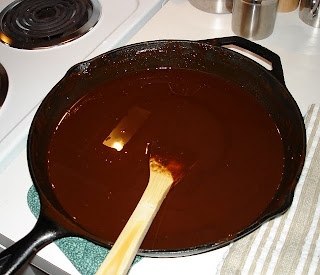Recipe: RouxPrep Time: 1 minute
Cooking Time: 45 min - 1 hr
Roux is a flour and oil mixture that is cooked and then used as a thickening agent in sauces, soups, and stews. Really, you can use any type of fat, including butter, lard, vegetable oil, etc.; however, if you are planning to cook a darker roux, use oils with a higher smoke point (like canola oils or peanut oils) to prevent the oil from burning.
You see, roux can be made with different levels of color. The flour and oil mixture starts off a pale white, and you can darken the roux over a medium-low heat through different color stages until it becomes dark brown. The darker the roux, the richer, nuttier the flavor. The darker the roux, the less thickening power you have. A
bashamel is made with a light roux and cream or milk, so because the roux mixture is light, a little goes a long way in thickening the sauce. For stews and gumbo, for example, the roux is darker and does not thicken the soup base as much, adding a richness without clumping.
Be careful, though. The roux can burn quickly. Once it has burned (you can tell by dark flecks appearing in the mixture), you must start over. To prevent the roux from burning, you must commit yourself to the making of the roux completely. Don't answer the phone, don't give instruction to your kids, simply stir and stir until it is ready. Be patient and stir constantly.
To begin your roux, mix:
1 cup all-purpose flour (NOT self-rising)
1 cup oil (butter is
ok for a lighter roux, but use canola or peanut oil for a darker roux, never use olive oil because of its low smoke point)
in a heavy sauce pan, one that is relatively flat and can hold heat well.
(I am using a large cast iron skillet, thanks Tams, and a larger batch for illustration.)
Turn on your stovetop to a medium heat (be patient, don't turn it up, or it is likely to burn).

Here is what the initial roux mixture will look like.
Notice that the flour and oil mixture looks a pale white. As the mixture heats up, it will begin to bubble. In this initial stage, I like to use a
whisk to mix the
ingredients well. You do not want any lumps, but a smooth, creamy consistency.
Continue
stirring until the mixture begins to bubble continuously.

As the roux begins to brown, I switch to a wooden spoon. You will want to move the roux mixture that is on the bottom of the pan around, so don't be afraid to run the spoon across the bottom of the pan continuously.
Continue to stir. You will begin to see tiny bubbles in the mixture.
If you want a super thickener, you can stop here, but the richest flavor goes to the patient.
Keep
stirring!
 This is a critical stage. You must not leave this pot. Stay with it, stirring the darkening roux from the bottom of the pan. Be sure to stir around the entire surface of the pan to ensure even browning and to avoid burning.
This is a critical stage. You must not leave this pot. Stay with it, stirring the darkening roux from the bottom of the pan. Be sure to stir around the entire surface of the pan to ensure even browning and to avoid burning.
As the browning continues, the bubbles will subside. At this stage, the thickening power of the mixture has diminished some. This stage would be best for stews.
But, if you want that deep, rich flavor that is the signature of gumbo, you will have to continue stirring.
 Once the roux reaches a milk-chocolate-brown color, you will want to remove the pan from the heat.
Once the roux reaches a milk-chocolate-brown color, you will want to remove the pan from the heat.
Once you have set the pan off of the fire, continue to stir as the mixture cools. The residual heat from the pan will continue to brown the roux. I usually continue to stir for at least 20 minutes, but it depends on the amount of roux mixture you have and how well your pan retains heat.
Once the mixture has stopped cooking, you can add it to your gumbo. Be careful not to add roux to cold water. Only add roux to hot water, and only add hot water to roux. Adding cold water will cause the roux to clump.
One final note: The ratio of 1 to 1 of flour and oil starts to break down as you increase the amount of flour. For example, for 3 cups of flour, you could get away with 2-2½ cups of oil.
Now that you have made a roux, the applications are endless. You can add roux to gumbo, crawfish etouffee, courtbullion, shrimp stew, and more! This same process is the basis for most french sauces.
A little recipe for the
joie de vivre!



